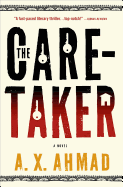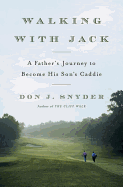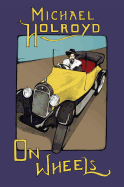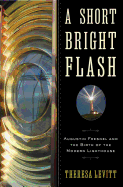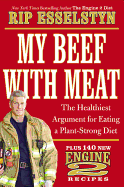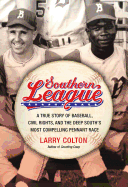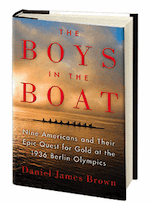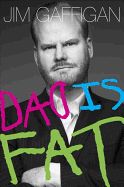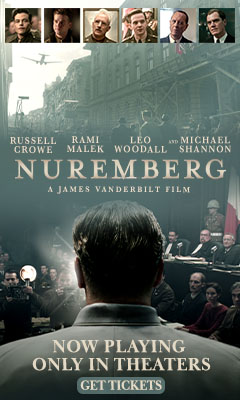Tuesday, June 4, 2013
So many great book ideas for fathers (and not-fathers); check out these, and find more in the reviews below.
Loopers: A Caddie's Twenty-Year Golf Odyssey by John Dunn. An entertaining insider's account about the vocation of caddying and the beautiful grounds where caddies ply their trade.
It's Only Slow Food Until You Try to Eat It: Misadventures of a Suburban Hunter Gatherer by Bill Heavey (Atlantic Monthly Press). Heavey lives inside the D.C. Beltway, not a prime spot for foraging, but he's game, and very funny.
Class A: Baseball in the Middle of Everywhere by Lucas Mann (Pantheon). Part memoir, part small-town history, this is an evocative, funny, poignant chronicle of a season of minor-league ball.
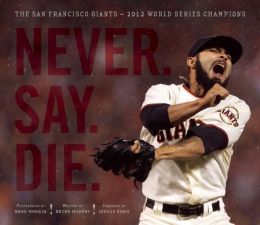
E.B. White on Dogs, edited by Martha White (Tilbury House). White's granddaughter has compiled letters, essays, poems and photographs by a master of prose and lover of dogs.
Everything Sings: Maps for a Narrative Atlas by Denis Wood (Siglio). Wood is a geographer who has created an unusual atlas of his half-square mile neighborhood in Raleigh, N.C. "Lester's Paper Route in Space and Time," "Rhythm of the Sun," "Jack-o'-lanterns"--it's maps, it's art, it's hard to describe, it's fascinating.
Bald Eagle Nest: A Story of Survival in Photographs by Kate Davis (Stackpole Books). Davis photographed a bald eagle pair over a nesting season as they raised their four chicks to adulthood. Stunning birds, stunning photos.
Saving Eagle Mitch: One Good Deed in a Wicked World by Barbara Chepaitis (Excelsior/SUNY Press). In 2010, a Navy SEAL rescued a wounded Steppe eagle in war-torn Afghanistan and decided to find it a safer home--a small act of grace that rippled into others' lives. --Marilyn Dahl, editor, Shelf Awareness for Readers
The Caretaker
by A.X. Ahmad
The protagonist of A.X. Ahmad's The Caretaker is a former officer in India's mountain division, patrolling the Siachen glacier between India and Pakistan. It's a no-man's land neither country particularly wants--though each fiercely wants to prevent the other from having it. Captain Ranjit Singh led a doomed squadron--16 Indian soldiers died--in a shady friendly-fire attack meant to discredit Pakistan and build Indian political support for war. When Singh refused to reveal the deception, he was court-martialed and imprisoned. After his release, his steadfast wife and young daughter reluctantly accompany him to Boston to escape further political persecution.
A devout Sikh committed to the symbolic uncut hair and turban of his religion, Singh finds nothing in Boston but menial labor and abuse until he takes his family to Martha's Vineyard to do landscaping for the wealthy. When winter comes and the island shuts down, Singh finds himself caretaker of several mansions... and Ahmad's leisurely novel of Indian culture shifts into a high-speed story of international espionage, troubled marriage, government deceit and murder.
Against the car chases, pit bull attacks, knife fights and adultery, Ahmad skillfully balances the internal ambiguity of Singh, "a brown man in a turban" struggling with his religious beliefs, marital traditions and military training in an America frightened and suspicious of all immigrants--and where it's impossible to get a good cup of chai. He is a complex character strong enough to drive what will likely be an interesting and welcome new series of literary crime novels. --Bruce Jacobs, founding partner, Watermark Books & Cafe, Wichita, Kansas.
Discover: A.X. Ahmad makes his literary crime fiction debut, introducing readers to the immigrant Indian Sikh Ranjit Singh.
Biography & Memoir
Walking with Jack: A Father's Journey to Become His Son's Caddie
by Don J. Snyder
"The smaller the ball used in the sport," George Plimpton once suggested, "the better the book." In January of 2007, Don Snyder and his 18-year-old son Jack flew to Scotland, the birthplace of golf, to play the famous courses at Carnoustie. Snyder hoped the daily rounds of wintery golf might nurture their tenuous father/son relationship and inspire Jack to pursue a collegiate golf scholarship. The motivating carrot for Jack: a PGA player card after college. The objective for his father was to carry his son's bag if he made the tour.
As writers frequently do, Snyder (Of Time and Memory) kept a diary of the next five years. Walking with Jack tells the story of Jack's performance with the University of Toledo's golf team, including his first national tournament and a suspension for poor grades. It tells of Snyder leaving his home in Maine to be an apprentice caddie in Scotland doing double loops for £100 tips. And, like all good sports books, it translates the challenges of the game into life lessons. Jack learns to persevere, "limiting the damage from mistakes," and finally gets his card. Snyder learns that a caddie is not just a bag carrier; as he writes, "there are those times when he carries his golfer as well." That's the really important lesson, just as Walking with Jack is really Snyder's story. The light bulb comes on when he realizes that being a good caddie is at the heart of being a good father. --Bruce Jacobs, founding partner, Watermark Books & Cafe, Wichita, Kan.
Discover: A father's five-year diary of his son's path to professional golf, which he plans to observe as his caddie.
On Wheels: Five Easy Pieces
by Michael Holroyd
English biographer Michael Holroyd (Lytton Strachey) takes a short trip down memory lane with the stylish automotive autobiography On Wheels.
As a young boy, Holroyd went to his grandparents' garage where he would comfortably nestle into their old car to read Conan Doyle and Rider Haggard. During his two years in the army, he served as the regiment's Motor Transport Officer--"no one seemed to mind that I didn't have a driving licence--later on I was told I could have awarded myself one." Instead, he took lessons from a "man who reminded me of a peculiarly fierce sergeant major let loose from the army." Later, he was able to teach his wife, novelist Margaret Drabble, to drive (she's better than he is).
There are also many wonderful anecdotes about Holroyd's biographical subjects and cars. The painter Augustus John took friends on a successful drive from London to Dorset, but since his driving lesson had "never touched on the philosophy of gear changing, the car had been in first gear from start to finish." And it was George Bernard Shaw, who loved bicycles and cars, who gave Lawrence of Arabia the motorcycle he was riding when he swerved to avoid some boys, crashed and died.
On Wheels is short, with lovely illustrations--the layout and design add quaintness and charm, making it an ideal present for drivers more enamored of the mystique and history of the motor car than its speedy, flashy side. --Tom Lavoie, former publisher
Discover: A nostalgic literary road trip with a witty, elegant guide.
History
Junius and Albert's Adventures in the Confederacy: A Civil War Odyssey
by Peter Carlson
Peter Carlson's Junius and Albert's Adventures in the Confederacy opens with the capture of its titular subjects near Vicksburg in 1863, then rewinds to show how they landed in such a predicament. Albert Richardson, an enterprising journalist for the New York Tribune, had decided to travel south as an undercover correspondent, and naturally chose his best friend and fellow newspaperman Junius Browne to accompany him. The stakes were high if they were discovered--the Tribune was reviled as a liberal abolitionist paper--but the two young men were game for adventure. After their capture, they spent nearly two years in a series of Confederate prisons before escaping, half-starved and freezing, to trek overland toward Union lines in December 1864.
Despite the serious and frequently tragic nature of Albert and Junius's story, the book's title signals the often playful tone that Carlson (K Blows Top) employs. The descriptions of Confederate prisons like Libby, Castle Thunder and Salisbury are horrific, but there is also the occasional scene of mirth--as when prisoners put on a variety show to celebrate the 4th of July. Besides Junius and Albert, the other colorful personalities in Carlson's history include a larger-than-life "Union pilot" skilled at guiding refugees over the mountains to freedom, and a beautiful young Southern horsewoman who rescues them during a perilous moment. With eccentric and likeable characters like these, Carlson's history successfully masquerades as an entertaining adventure story. --Julia Jenkins, librarian and blogger at pagesofjulia
Discover: Adventure, suspense, and a dash of romance make for a highly readable--and absolutely true--Civil War story.
A Short Bright Flash: Augustin Fresnel and the Birth of the Modern Lighthouse
by Theresa Levitt
In the 18th century, many European lighthouses proved more harmful than helpful to passing ships. Their weak beams, shoddy equipment and inconsistent timing often lured ships nearer to shore, only to have them founder on the rocks. The work of French physicist Augustin Fresnel (1788-1827) proved a crucial development in the science of light and the future of maritime navigation, as Theresa Levitt recounts in A Short Bright Flash.
Trained as an engineer, Fresnel devoted his spare time to physics, including a radical series of experiments on the wavelike behavior of light. Though his findings shocked the French scientific community (where light was still widely believed to be a particle), Fresnel persisted in his research. Eventually, he constructed a new type of lens that used a complex set of prisms to both reflect and refract light. When installed in lighthouses, the beams from his lenses outshone those of competitors by many miles, leading to Fresnel's involvement in France's Lighthouse Commission and his work in lighting the entire French coast.
Fresnel died young, but his brother, Leonor, carried on Augustin's work. Levitt traces the spread of Fresnel's ideas and lenses to England, Scotland and eventually the United States, devoting most of an interesting (if somewhat tangential) chapter to the prominence of lighthouses in the Civil War. Although the politics of lighthouse governance occasionally slow the narrative down, Levitt weaves together science and history to explore the impact of a man who helped light the way for sailors around the world. --Katie Noah Gibson, blogger at Cakes, Tea and Dreams
Discover: A science historian reveals the role of French physicist Augustin Fresnel in creating a powerful kind of lighthouse lens that revolutionized maritime navigation.
Current Events & Issues
Midnight in Mexico: A Reporter's Journey Through a Country's Descent into Darkness
by Alfredo Corchado
The 2,000-mile border between Mexico and the United States is the world's 10th longest and the most heavily trafficked, with some 350 million people crossing every year. Alfredo Corchado and three of his siblings were born in Mexico, before his parents entered the U.S. as part of the Bracero program to provide much needed labor after World War II. As he grew up in El Paso, crossing back and forth to Ciudad Juárez was taken for granted by his family and friends.
Since 1994, Corchado has lived in Mexico City, first as a Dallas Morning News correspondent and then as a bureau chief. As such, he's had personal access to the four Mexican presidents who held office as the nation made the transition to a full-fledged multi-party democracy. During this time, roughly 170 Mexican journalists were killed or "disappeared" in the course of reporting cartel violence, police bribery and political corruption.
Midnight in Mexico is Corchado's attempt to describe--and more importantly understand--both his personal heritage and his dangerous occupation. In doing so, he provides a glimpse of the deep intertwined roots of the United States and Mexico. As he concludes while looking across the Texas border: "We are the same geography, one blood, two countries dancing out of step, two souls still clashing. My feet were planted on U.S. soil. Mexico was in my sights. I did not want to be anywhere else or anyone else." --Bruce Jacobs, founding partner, Watermark Books & Cafe, Wichita, Kan.
Discover: The moving memoir of a Mexican-born American journalist covering the dangerous world of Mexican cartels and political corruption.
Health & Medicine
My Beef with Meat: The Healthiest Argument for Eating a Plant-Strong Diet--Plus 140 New Engine 2 Recipes
by Rip Esselstyn
The cover photograph for My Beef with Meat, showing a handsome Texas firefighter, may bring to mind words like courageous, heroic and virile. But "plant-strong" may not be on the list--unless one already knows Rip Esselstyn for his Engine 2 (E2) Diet and as the son of the surgeon whose cardiac disease-reversing program may have saved President Clinton's life.
Impressed by his father's extensive research and by his own health and vitality after becoming a vegetarian, Esselstyn published The Engine 2 Diet in 2009; he immediately received a visit to his firehouse from the Texas Beef Council, bearing gifts of brisket and other carnivorous treats. However, Esselstyn believes "things have changed dramatically... all over the country people are learning about healthy plant-based diets." In My Beef with Meat, Esselstyn debunks 36 common myths about meat-based diets (e.g., plant-based diets do not lack protein), providing research, testimonials and a common sense perspective.
"People always ask me how I was able to get a bunch of burger-munching, ice cream-scarfing, milk-guzzling Texas firefighters to eat a healthy, whole food, plant-strong diet," he writes. "It's all about making and eating kickass food that everyone from housewives to firefighters, from kids to seniors will truly love."
Each of the 140 "kickass" recipes include no animal products or by-products, no added extracted oils, little salt, minimally processed sugars, and are simple to prepare. They range from Savory Shiitake and Cheesy Oats to Spicy Southern Grits, PBJB (the usual, plus bananas) Burrito and many more. Esselstyn aims to make a "plant-strong" diet a desire, rather than a duty. --Kristen Galles, blogger at Book Club Classics
Discover: Rip Esselstyn says, "If a firehouse full of good ol' boys in Austin, Texas, can [go meatless], any house, and I mean any house, can do this."
Sports
Southern League: A True Story of Baseball, Civil Rights, and the Deep South's Most Compelling Pennant Race
by Larry Colton
After Larry Colton came out of the minors and washed out of major league baseball after pitching just one game with the Phillies in 1968, he took his UC Berkeley degree and reinvented himself as a writer (Counting Coup; Goat Brothers). When Johnny "Blue Moon" Odom came to the AA Southern League's Birmingham Barons in 1964, though, he was an uneducated, fatherless 19-year-old African-American with a gifted fastball--and that's all. He had no plan B.
In Southern League, Colton tells the story of Odom and his teammates, black and white, as they struggled to fight their way into "the bigs" in one of America's most racially volatile cities during the peak of the Civil Rights movement. Colton applies his personal knowledge of the league--he played for the Macon Peaches--to his account of the ballparks (including Birmingham's legendary Rickwood Field), the players and the segregated small-town hotels and diners they encountered on the road. The Barons finished one game back of Lynchburg--quite possibly because Odom was brought up to the Kansas City A's shortly before the season's end. (He would shuttle between the major and minor leagues several times over the next few years before hitting his stride after the A's moved to Oakland.) If the integrated Barons didn't win the pennant, at least they helped bury some of Bull Connor's Birmingham bigotry--and that's its own kind of winning season. --Bruce Jacobs, founding partner, Watermark Books & Cafe, Wichita, Kas.
Discover: A minor league baseball team playing in one of the Deep South's most notoriously segregated cities took its talented--and integrated--lineup nearly all the way to the championship.
The Boys in the Boat: Nine Americans and Their Epic Quest for Gold at the 1936 Berlin Olympics
by Daniel James Brown
The triumphant moment at the 1936 Berlin Olympics when the eight rowers and one coxswain in the Husky Clipper won the gold medal for the United States in the eight-oared crew race has not only gone down in Olympic record books but also is captured in the glorious rowing sequences in Leni Riefenstahl's Olympia, one of the greatest films about athletic competitions.
To some--including Adolf Hitler, who watched that race from the viewing platform at Langer See regatta grounds in Grünau--the University of Washington crew representing the United States had scored an upset. To Al Ulbrickson, the Washington rowing coach, the victory was not entirely a surprise, although Ulbrickson, nicknamed "The Dour Dane" for his extreme reticence, was not a guy to risk jinxing a race by even thinking a win might be a sure thing.
Ulbrickson may not have been talkative, but he was fiercely competitive; for years he had been obsessed with the winning record of Ky Ebright, head coach at the University of California, Berkeley, Ulbrickson's arch rival. Ebright had led his crews to Olympic gold medals in 1928 and 1932. Ulbrickson was determined to develop rowers who would best those Ebright coached at Berkeley. And in April 1933 his obsession finally paid off when the University of Washington crews swept the annual Pacific Regatta.
Those 1933 wins emboldened Ulbrickson and Tom Bolles, his freshman rowing coach, to launch an intensive drive to find and train a crew that could capture Olympic Gold in the 1936 Games. Bolles and Ulbrickson knew the qualities they were looking for: potential for raw power, stamina, willpower, the intelligence to master rowing technique and the ability to drop all traces of personal ego once seated in the boat--even if these new recruits had never before rowed a boat. As George Pocock, who built the Husky Clipper and so many other prize racing shells, said, "What matters more than how hard a man rows is how well everything he does in the boat harmonizes with what the other fellows are doing."
In the fall of 1933, a new crop of rowing candidates arrived on the Seattle campus. One of those was Joe Rantz. Strong, disciplined, earnest and determined to break free of a childhood history of poverty and abandonment, Rantz saw making the rowing team as one of the ways to fund college—not because there was anything like athletic scholarships back then but because being on the crew meant he was eligible for part-time jobs on campus. Rantz was almost made to order for his coaches' requirements. The other rowers who trained with Rantz filled the bill just as he did.
To make the crew and stay on the roster was hard work, with mandatory daily workouts and intense competition for a rowing position. And, like most coaches in 1933, Tom Bolles and Al Ulbrickson were the undisputed bosses with a strictly business attitude, constantly monitoring the performance of their rowers.
Daniel James Brown's enthralling history of the run-up to the 1936 Olympic victory shows in vivid detail the many factors, including Ulbrickson's strategy for keeping his rowers on edge and hungry, that had to come together between 1933 to 1936 so that the Husky Clipper and its crew would be first to cross the finish line at Berlin's Langer See regatta course.
With nail-biting suspense, Brown shows how each of the seven key qualifying races before the Berlin Olympics was hard fought. Victories were not only the result of skill, dedication, planning, teamwork and strategy, but also the weather conditions on specific courses--the races on Seattle's Lake Washington, the Oakland Estuary near Berkeley and the Hudson River at Poughkeepsie for the annual Intercollegiate Rowing Association Regatta. With calm assurance and telling detail, Brown establishes that rare, thrilling you-are-there quality that epitomizes the best in sports writing.
What's more, Brown's storytelling captures the personalities and psychologies of all the players, from the behind-the-scenes boat builder and rowing guru George Pocock to the brilliant and self-assured coxswain Bobby Moch, the shortest man in the boat. Brown completes his complex portrait of Al Ulbrickson with the coach's statement to United Press International, after the Olympic victory was safely in hand, finally allowing himself to say what he could never say before: the crew was "the finest I ever saw seated in a shell. And I've seen some corking boatloads."
Brown eloquently sums up all that he's shown us contributing to that amazing Olympic victory in Berlin: "Everything had converged: the right oarsmen, with the right attitudes, the right personalities, the right skills; the perfect boat, sleek, balanced, and wickedly fast; a winning strategy at both long and short distances; a coxswain with the guts and smarts to make hard decisions and make them fast." --John McFarland
Humor
Dad Is Fat
by Jim Gaffigan
The most shocking part of comedian Jim Gaffigan's hilarious Dad Is Fat is that he and his wife live in a tiny two-bedroom apartment with five children. As he explains the long, painstaking process of putting the children to bed and recounts the arduous task of applying sunscreen to five extremely pale children, it's comical for the sheer fact that it's not happening to you.
As his acting career has skyrocketed, Gaffigan has also spent the last seven years doing some major baby-making, and in the process provided himself prime material. Constantly sleep-deprived, often used as a human trampoline by his offspring, he nonetheless gives his family his all, even renting a colossal tour bus so he can take them all with him on the road. That's dedication. Or insanity. Gaffigan would argue being a father ensures both.
Although the comedian dislikes being referred to as "family-friendy" (his argument is that anything family friendly generally stinks--think chain restaurants), his writing has a likable vibe to it that conjures up a chat with the funny dad at the playground. While he pokes fun at hipster parents who name their children after spices, the person who gets the most ridicule in Dad Is Fat is Gaffigan himself. The added element that he must navigate the wilds of New York City with his brood makes for good reading, whether his children are peeing in the sandbox of a public park or licking subway poles. --Natalie Papailiou, author of blog MILF: Mother I'd Like to Friend
Discover: Comedian Jim Gaffigan's side-splitting observations on parenting five children in a two-bedroom Manhattan apartment.
Children's & Young Adult
Better to Wish
by Ann M. Martin
Ann M. Martin (Ten Rules for Living with My Sister) begins a quartet spanning four generations of a family with a heartfelt novel that deals with some weighty issues. Yet Martin infuses enough hope into the novel so it never feels heavy.
Set in the 1930s, the book covers 15 years, and follows eight-year-old Abby Nichols to her early 20s. Though the family business is successful during the Great Depression, all is not well with the Nichols family. Abby and her younger sister, Rose, navigate from childhood to adolescence while dealing with Pop's anger, prejudice and control, as well as the mysterious condition plaguing their baby brother. In later chapters, their father surreptitiously sends Abby's mentally challenged brother away to boarding school, and their mother suffers from what would today likely be called post-partum depression. The book may well remind readers of the Little House on the Prairie series, with Abby's overriding characteristic of determination in the face of hardship.
Better to Wish walks a fine line, managing a remarkably relevant, current feel while retaining the charm of yesteryear. Abby becomes a terrific role model, choosing to follow her own dreams rather than focusing on marriage and simple clerical work, as her peers do. She's an independent, fiercely lovable heroine. This book is sure to become an instant favorite and draw readers back for subsequent stories of Abby's daughter, granddaughter and great-granddaughter. --Kyla Paterno, trade book buyer and blogger, Garfield Book Company at PLU
Discover: An independent-minded young woman navigates life, love and tragedy in the 1930s.
Toys in Space
by Mini Grey
Mini Grey follows in the tradition of her picture books starring Traction Man with the tale of a group of toys left in the yard, who combat their fear of the dark with an imaginative story of derring-do.
"That summer night, for the first time, the toys were left outside," the book begins, setting a scene for possible catastrophe. Will it rain? Will a dog see them as chew toys? Will they be coveted by a neighbor child? No. "The sun went down, the sky grew dark, and, for the very first time...," reads the text in three horizontal panels with a time-lapse of the dimming sunlight, "the toys saw this." With a turn of the page, Grey reveals the wonder of the starlit sky dominating a double-page spread: "Everyone was quiet for a while." But then their anxieties begin to creep up ("I don't like the dark!"; "I may get damp!"). WonderDoll starts improvising a story in which all the toys play a role, with a spaceship and an alien called Hoctopize in search of its lost toy, Cuddles. Grey cleverly divides the pages to indicate the story WonderDoll tells, and the comments and suggestions added by her toy compatriots.
In all of her books, Grey extols the benefits of imaginative play in real time with real settings and real stuffed toys and action figures. Her own leaps of creativity cannot help but inspire the same instinct in boys and girls everywhere. --Jennifer M. Brown, children's editor, Shelf Awareness
Discover: Mini Grey's latest flight of fancy, with toys that must make it through a night under the stars.
| Advertisement nuremberg--now playing in theaters |




